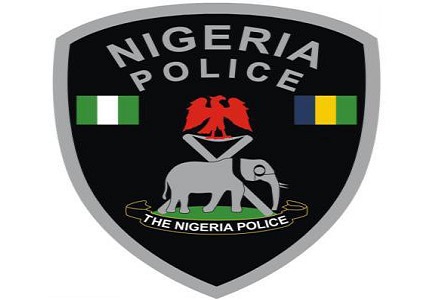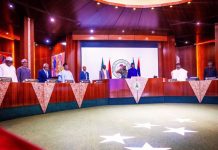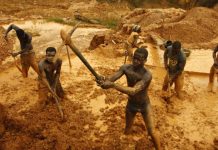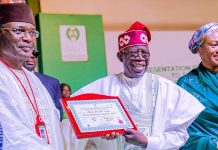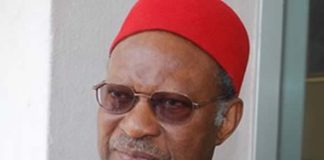The Nigerian Police (NP) formerly called The Nigeria Police Force is the principal law enforcement agency in Nigeria. There are currently plans to increase the staff strength of the force by adding new recruits. The NP is a very large organization consisting of 36 State Commands grouped into 12 zones and 7 administrative organs. The agency is currently headed by an Inspector-General of Police, IGP Ibrahim Kpotun Idris.
History of Nigeria Police Force
The Nigeria Police was first established in 1820. In 1879 a 1,200-member armed paramilitary Hausa Constabulary was formed. In 1896, the Lagos Police was established. A similar force, the Niger Coast Constabulary, was formed in Calabar in 1894 under the newly proclaimed Niger Coast Protectorate. In the north, the Royal Niger Company set up the Royal Niger Company Constabulary in 1888. When the protectorates of Northern and Southern Nigeria were proclaimed in the early 1900s, part of the Royal Niger Company Constabulary became the Northern Nigeria Police, and part of the Niger Coast Constabulary became the Southern Nigeria Police. During the colonial period, most police were associated with local governments (native authorities). In the 1960s, under the First Republic, these forces were first regionalized and then nationalized.
The NPF performed conventional police functions and was responsible for internal security generally; for supporting the prison, immigration, and customs services; and for performing military duties within or outside Nigeria as directed. Plans were announced in mid-1980 to expand the force to 200,000. By 1983, according to the federal budget, the strength of the NPF was almost 152,000, but other sources estimated it to be between 20,000 and 80,000. Reportedly, there were more than 1,300 police stations nationwide. Police officers were not usually armed but were issued weapons when required for specific missions or circumstances. They were often deployed throughout the country, but in 1989, the military president, Ibrahim Babangida, announced that a larger number of officers would be posted to their native areas to facilitate police- community relations.
The Nigerian Police (NP) is designated by Section 194 of the 1979 Constitution as the national police of Nigeria with exclusive jurisdiction throughout the country. Constitutional provision also exists, however, for the establishment of separate NPF branches “forming part of the armed forces of the Federation or for their protection of harbours, waterways, railways and airfields.” One such branch, the Port Security Police, was reported by different sources in 1990 to have between 1,500 and 12,000 personnel.
In late 1986, the NPF was reorganized nationwide into seven area commands, which superseded a command structure corresponding to each of the States of Nigeria. Each command is under a Commissioner of police and was further divided into police provinces and divisions under local officers. NPF headquarters, which was also an area command, supervised and coordinated the other area commands. Later these Area Commands were grouped under Zonal Commands as follows:
Zone 1, Headquartered in Kano; with Kano, Katsina, and Jigawa Commands
Zone 2, Headquartered in Lagos; with Lagos, and Ogun Commands
Zone 3, Headquartered in Yola; with Adamawa, and Gombe Commands
The 1986 NPF reorganization was occasioned by a public eruption of tension between the police and the army. A superintendent was suspended for grumbling that the army had usurped police functions and kept police pay low, and there were fights between police and army officers over border patrol jurisdiction. The armed forces Chief of Staff announced a thorough reorganization of the NPF into the seven new area commands and five directorates (criminal investigations, logistics, supplies, training, and operations) under Deputy Inspectors-General. About 2,000 constables and 400 senior police officers were dismissed by mid-1987, leaving senior police officers disgruntled.
In mid-1989, a second reorganization was carried out. In 1989, the NPF also created a Quick Intervention Force in each state, separate from the mobile police units, specifically to monitor political events and to quell unrest during the transition to civil rule. Each state unit of between 160 and 400 policemen was commanded by an Assistant Superintendent and equipped with vehicles, communications gear, weapons, and crowd control equipment, including cane shields, batons, and tear gas.
A Federal Investigation and Intelligence Bureau (FIIB) was to be set up as the successor to the Directorate of Intelligence and Investigation; three directorates were established for operations, administration, and logistics, each headed by a Deputy Inspector-General.
The Directorate of Operations was subdivided into four units under a deputy director, operations, training, communications, and the Mobile Police. The Directorate of Administration was composed of an administration unit headed by an Assistant Inspector-General (AIG), and of budget and personnel units under Commissioners.
The Directorate of Logistics had four units – procurement, workshop/transport, supply, and work/maintenance headed by AIGs. The zonal arrangements were retained. However, AIGs were authorized to transfer officers up to the rank of Chief Superintendent, to set up provost units, to deploy mobile units, and to promote officers between the ranks of sergeant and inspector. The above three Directorates were renamed Departments
In most parts of the country, however, the people view the policeman in or out of uniform with great suspicion. They do not trust policemen generally. The government’s efforts to make Nigerians see policemen as their friends seemed to have failed flat.






